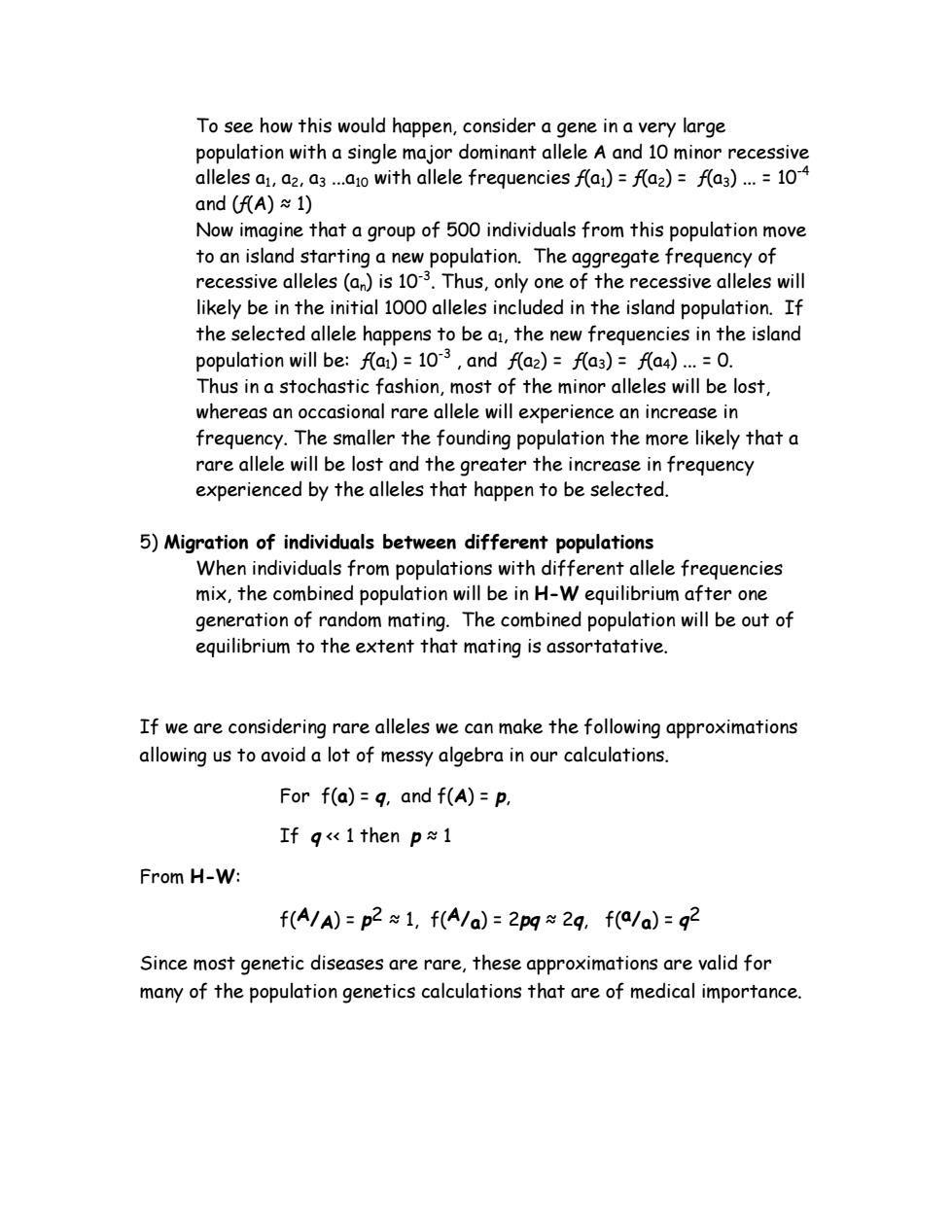正在加载图片...

To see how this would happen,consider a gene in a very large population with a single major dominant allele A and 10 minor recessive alleles a1,a2,a3 ...a1o with allele frequencies f(a)=f(a2)=f(a3)...=104 and (f(A)1) Now imagine that a group of 500 individuals from this population move to an island starting a new population.The aggregate frequency of recessive alleles (an)is 10-3.Thus,only one of the recessive alleles will likely be in the initial 1000 alleles included in the island population.If the selected allele happens to be a1,the new frequencies in the island population will be:f(a)=103 and f(az)=f(a3)=f(a)...=0. Thus in a stochastic fashion,most of the minor alleles will be lost, whereas an occasional rare allele will experience an increase in frequency.The smaller the founding population the more likely that a rare allele will be lost and the greater the increase in frequency experienced by the alleles that happen to be selected. 5)Migration of individuals between different populations When individuals from populations with different allele frequencies mix,the combined population will be in H-W equilibrium after one generation of random mating.The combined population will be out of equilibrium to the extent that mating is assortatative. If we are considering rare alleles we can make the following approximations allowing us to avoid a lot of messy algebra in our calculations. For f(a)=q,and f(A)=p. Ifq<1 then p≈1 From H-W: fA/A)=p2≈1,fA/a)=2pg2q,fo/a)=g2 Since most genetic diseases are rare,these approximations are valid for many of the population genetics calculations that are of medical importance.To see how this would happen, consider a gene in a very large population with a single major dominant allele A and 10 minor recessive alleles a1, a2, a3 ...a10 with allele frequencies ƒ(a1) = ƒ(a2) = ƒ(a3) ... = 10-4 and (ƒ(A) ≈ 1) Now imagine that a group of 500 individuals from this population move to an island starting a new population. The aggregate frequency of recessive alleles (an) is 10-3. Thus, only one of the recessive alleles will likely be in the initial 1000 alleles included in the island population. If the selected allele happens to be a1, the new frequencies in the island population will be: ƒ(a1) = 10-3 , and ƒ(a2) = ƒ(a3) = ƒ(a4) ... = 0. Thus in a stochastic fashion, most of the minor alleles will be lost, whereas an occasional rare allele will experience an increase in frequency. The smaller the founding population the more likely that a rare allele will be lost and the greater the increase in frequency experienced by the alleles that happen to be selected. 5) Migration of individuals between different populations When individuals from populations with different allele frequencies mix, the combined population will be in H-W equilibrium after one generation of random mating. The combined population will be out of equilibrium to the extent that mating is assortatative. If we are considering rare alleles we can make the following approximations allowing us to avoid a lot of messy algebra in our calculations. For f(a) = q, and f(A) = p, If q << 1 then p ≈ 1 From H-W: f(A/A) = p2 ≈ 1, f(A/a) = 2pq ≈ 2q, f(a/a) = q2 Since most genetic diseases are rare, these approximations are valid for many of the population genetics calculations that are of medical importance